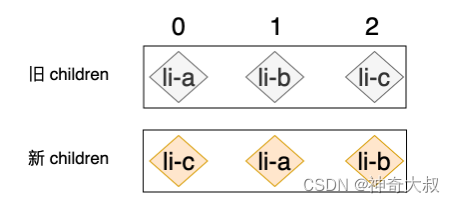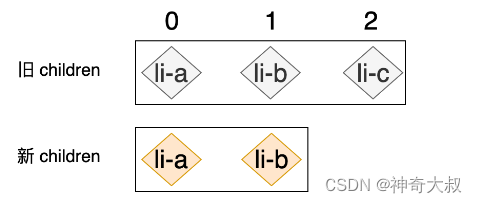文章目录 diff 算法 没有 key 时的diff 通过 key 的 diff 查找需要移动的节点 移动节点 添加新元素 移除不存在的元素 缺点
根据新旧列表的长度进行 diff 公共长度相同的部分直接patch 新列表长度>旧列表长度则添加,否则删除 function patchChildren ( prevChildFlags, nextChildFlags, prevChildren, nextChildren, container
) { switch ( prevChildFlags) { default : switch ( nextChildFlags) { case ChildrenFlags. SINGLE_VNODE : case ChildrenFlags. NO_CHILDREN : default : const prevLen = prevChildren. lengthconst nextLen = nextChildren. lengthconst commonLength = prevLen > nextLen ? nextLen : prevLenfor ( let i = 0 ; i < commonLength; i++ ) { patch ( prevChildren[ i] , nextChildren[ i] , container) } if ( nextLen > prevLen) { for ( let i = commonLength; i < nextLen; i++ ) { mount ( nextChildren[ i] , container) } } else if ( prevLen > nextLen) { for ( let i = commonLength; i < prevLen; i++ ) { container. removeChild ( prevChildren[ i] . el) } } break } break }
} 通过 key 就能够明确的知道新旧 children 中节点的映射关系,复用旧节点进行 patch
for ( let i = 0 ; i < nextChildren. length; i++ ) { const nextVNode = nextChildren[ i] let j = 0 for ( j; j < prevChildren. length; j++ ) { const prevVNode = prevChildren[ j] if ( nextVNode. key === prevVNode. key) { patch ( prevVNode, nextVNode, container) break } }
}
如果在寻找的过程中遇到的节点索引呈现递增趋势,则说明新旧 children 中节点顺序相同,不需要移动操作。相反的,如果在寻找的过程中遇到的索引值不呈现递增趋势,则说明需要移动操作 因为 diff 是在旧真实节点列表上根据新旧虚拟 vnode 列表进行的真实移动,所以为了保证移动旧列表后的相对位置正确,很多时候都通过insertBefore 替换 appendChild 取出新 children 的第一个节点,即 li-c,并尝试在旧 children 中寻找 li-c,结果是我们找到了,并且 li-c 在旧 children 中的索引为 2。 取出新 children 的第二个节点,即 li-a,并尝试在旧 children 中寻找 li-a,也找到了,并且 li-a 在旧 children 中的索引为 0。 递增的趋势被打破了,我们在寻找的过程中先遇到的索引值是 2,接着又遇到了比 2 小的 0,这说明在旧 children 中 li-a 的位置要比 li-c 靠前,但在新的 children 中 li-a 的位置要比 li-c 靠后。这时我们就知道了 li-a 是那个需要被移动的节点,我们接着往下执行 取出新 children 的第三个节点,即 li-b,并尝试在旧 children 中寻找 li-b,同样找到了,并且 li-b 在旧 children 中的索引为 1。 我们发现 1 同样小于 2,这说明在旧 children 中节点 li-b 的位置也要比 li-c 的位置靠前,但在新的 children 中 li-b 的位置要比 li-c 靠后。所以 li-b 也需要被移动。 在当前寻找过程中在旧 children 中所遇到的最大索引值。如果在后续寻找的过程中发现存在索引值比最大索引值小的节点,意味着该节点需要被移动。
let lastIndex = 0
for ( let i = 0 ; i < nextChildren. length; i++ ) { const nextVNode = nextChildren[ i] let j = 0 for ( j; j < prevChildren. length; j++ ) { const prevVNode = prevChildren[ j] if ( nextVNode. key === prevVNode. key) { patch ( prevVNode, nextVNode, container) if ( j < lastIndex) { } else { lastIndex = j} break } }
} 新 children 中的第一个节点是 li-c,它在旧 children 中的索引为 2,由于 li-c 是新 children 中的第一个节点,所以它始终都是不需要移动的,只需要调用 patch 函数更新即可 function patchElement ( prevVNode, nextVNode, container ) { const el = ( nextVNode. el = prevVNode. el)
}
接下来是新 children 中的第二个节点 li-a,它在旧 children 中的索引是 0,由于 0 < 2 所以 li-a 是需要移动的节点,通过观察新 children 可知,新 children 中 li-a 节点的前一个节点是 li-c,所以我们的移动方案应该是:把 li-a 节点对应的真实 DOM 移动到 li-c 节点所对应真实 DOM 的后面 所以我们的思路应该是想办法拿到 li-c 节点对应真实 DOM 的下一个兄弟节点,并把 li-a 节点所对应真实 DOM 插到该节点的前面
let lastIndex = 0
for ( let i = 0 ; i < nextChildren. length; i++ ) { const nextVNode = nextChildren[ i] let j = 0 for ( j; j < prevChildren. length; j++ ) { const prevVNode = prevChildren[ j] if ( nextVNode. key === prevVNode. key) { patch ( prevVNode, nextVNode, container) if ( j < lastIndex) { const refNode = nextChildren[ i - 1 ] . el. nextSiblingcontainer. insertBefore ( prevVNode. el, refNode) } else { lastIndex = j} break } }
}
节点 li-d 在旧的 children 中是不存在的,所以当我们尝试在旧的 children 中寻找 li-d 节点时,是找不到可复用节点的,这时就没办法通过移动节点来完成更新操作,所以我们应该使用 mount 函数将 li-d 节点作为全新的 VNode 挂载到合适的位置。 查找旧节点是否存在 li-d 的 key ,不存在则新增节点 如何才能保证 li-d 节点始终被添加到 li-a 节点的后面呢?答案是使用 insertBefore 方法代替 appendChild 方法,因为需要在已存在的真实节点列表进行移动,这样能够保证相对位置正确 let lastIndex = 0
for ( let i = 0 ; i < nextChildren. length; i++ ) { const nextVNode = nextChildren[ i] let j = 0 , find = false for ( j; j < prevChildren. length; j++ ) { const prevVNode = prevChildren[ j] if ( nextVNode. key === prevVNode. key) { find = true patch ( prevVNode, nextVNode, container) if ( j < lastIndex) { const refNode = nextChildren[ i - 1 ] . el. nextSiblingcontainer. insertBefore ( prevVNode. el, refNode) break } else { lastIndex = j} } } if ( ! find) { const refNode = i - 1 < 0 ? prevChildren[ 0 ] . el: nextChildren[ i - 1 ] . el. nextSiblingmount ( nextVNode, container, false , refNode) }
} 先找到当前遍历到的节点的前一个节点,即 nextChildren[i - 1],接着找到该节点所对应真实 DOM 的下一个子节点作为 refNode,即 nextChildren[i - 1].el.nextSibling,但是由于当前遍历到的节点有可能是新 children 的第一个节点,这时 i - 1 < 0,这将导致 nextChildren[i - 1] 不存在,所以当 i - 1 < 0 时,我们就知道新的节点是作为第一个节点而存在的,这时我们只需要把新的节点插入到最前面即可,所以我们使用 prevChildren[0].el 作为 refNode
function mount ( vnode, container, isSVG, refNode ) { const { flags } = vnodeif ( flags & VNodeFlags. ELEMENT ) { mountElement ( vnode, container, isSVG, refNode) }
}
function mountElement ( vnode, container, isSVG, refNode ) { refNode ? container. insertBefore ( el, refNode) : container. appendChild ( el)
}
新的 children 中已经不存在 li-c 节点了,所以我们应该想办法将 li-c 节点对应的真实 DOM 从容器元素内移除。但我们之前编写的算法还不能完成这个任务,因为外层循环遍历的是新的 children,所以外层循环会执行两次,第一次用于处理 li-a 节点,第二次用于处理 li-b 节点,此时整个算法已经运行结束了。 所以,我们需要在外层循环结束之后,再优先遍历一次旧的 children,并尝试拿着旧 children 中的节点去新 children 中寻找相同的节点,如果找不到则说明该节点已经不存在于新 children 中了,这时我们应该将该节点对应的真实 DOM 移除 let lastIndex = 0
for ( let i = 0 ; i < nextChildren. length; i++ ) { const nextVNode = nextChildren[ i] let j = 0 , find = false for ( j; j < prevChildren. length; j++ ) { } if ( ! find) { }
}
for ( let i = 0 ; i < prevChildren. length; i++ ) { const prevVNode = prevChildren[ i] const has = nextChildren. find ( nextVNode => nextVNode. key === prevVNode. key) if ( ! has) { container. removeChild ( prevVNode. el) }
}
在这个例子中,我们可以通过肉眼观察从而得知最优的解决方案应该是:把 li-c 节点对应的真实 DOM 移动到最前面即可,只需要一次移动即可完成更新。然而,React 所采用的 Diff 算法在更新如上案例的时候,会进行两次移动: 第一次把 li-a 移动到 li-c 后面 第二次把 li-b 移动到 li-a 后面 








模式)
)





)
)

![[LitCTF 2023]Http pro max plus](http://pic.xiahunao.cn/[LitCTF 2023]Http pro max plus)




)
